Ever wonder where the seemingly disparate worlds of punk rock, post-modern classical music, and electronics might intersect? Since the mid 1970s, Rhys Chatham has made it his mission in life to find out, and over the years he's learned that the differences aren't as cut-and-dried as they seem.
As a student of synthesizer guru Morton Subotnick and avant-garde aesthete La Monte Young, Chatham was awakened early to the possibilities of the stripped-down “minimalist" style of composition that was popularized by Young, Terry Riley, Steve Reich and Philip Glass—all of whom exerted a profound influence, either as residents or frequent visitors, on New York's burgeoning downtown art scene in the late '60s and early '70s. But one night in May 1976, Chatham made his first visit to the punk rock mecca CBGB, and his musical direction was changed forever. Then 23, he was playing flute in the Love of Life Orchestra, an avant-garde ensemble with rock proclivities founded by saxophonist and composer Peter Gordon. The two had been walking home from a rehearsal, when it came to light that Chatham had never been to a live rock show.
It's a story Chatham still relishes retelling today, because it set him on the path to adopting the electric guitar as his main instrument and to writing one of his most enduring works. “Peter just laughed and said, 'You know, there's a good band playing at this club down the street. Why don't we go down and see them?' And as it turned out, the band was the Ramones. They had just put out their first album, and they were really at their best. I had never seen anything like it in my life—these tall, skinny, handsome guys playing three-chord rock, you know?"
Chatham was jolted by the raw, primal connection to the minimalist music he was playing and composing. He saw how he could define his own hybrid style, in the same way that Young and Riley had drawn from Indian classical music, and Reich from West African music. “Maybe they were playing three chords, and I was only playing one," Chatham says. “But I felt something in common with them, so I had an epiphany at CBGB. Fortunately for me, the guitarist in the Love of Life Orchestra had just gotten a Stratocaster, so he lent me his Telecaster and he showed me how to play barre chords and a simple blues riff. That put me to work on practicing, and the rest is history."
and the center."
Chatham soon formed a short-lived band called Arsenal with guitarist Nina Canal. One day at his apartment, while they were jamming on a one-chord riff in E, Chatham hit the low E string and heard reams of melodies in the overtones. Canal suggested he make a piece of music out of it, which became Guitar Trio—these days G3 for short, and still a staple of Chatham's live set when he has a band with him. In 2008, he released Guitar Trio Is My Life!, a box set featuring multiple live performances of the piece.
With three guitarists vamping in E over a driving, krautrock-style beat, Chatham had unwittingly joined the ranks of New York's burgeoning anti-pop “no wave" movement, spearheaded by bands like James Chance and the Contortions, DNA, Glenn Branca's Theoretical Girls, and many more. Guitar Trio also became a favorite of Thurston Moore and Sonic Youth, as well as Robert Poss and Band of Susans, and down through the years has influenced Tortoise, Godspeed You! Black Emperor, and other art-rock bands with its hypnotic, slow-building detonation of sound.
Chatham moved to Paris in 1988, but he has always maintained a close connection to the New York music scene and has kept his ears open for young bands with a minimalist streak. In that vein, the Brooklyn-based five-piece Oneida came up on his radar. The band takes a page from the Steve Reich handbook, without overtly paying tribute. They place importance on rhythm and repetitive grooves, but with two fiery guitarists—Shahin “Showtime" Motia and Hanoi “Baby" Jane, who tend to favor Gibson Les Pauls and SGs through Marshall stacks—and the inexhaustible Kid Millions (neé John Colpitts) on drums, they can also switch effortlessly between hard psychedelic rock, freestyle noise-splatter, and ambient drones with sure-footed commitment.
All this impressed Chatham when he first hooked up with Oneida at their rehearsal studio in Brooklyn's Bushwick neighborhood, but he still wondered how they would work together. “I was expecting them to be a rock group with a backbeat, you know? With the kind of music I was doing and with my equipment setup, I wasn't sure at all. I had a Boomerang III with me, a loop delay system, so it's a little on the abstract side. I suppose I've played that kind of music over a backbeat before, but in general it works best with someone who plays more on the free side of things."
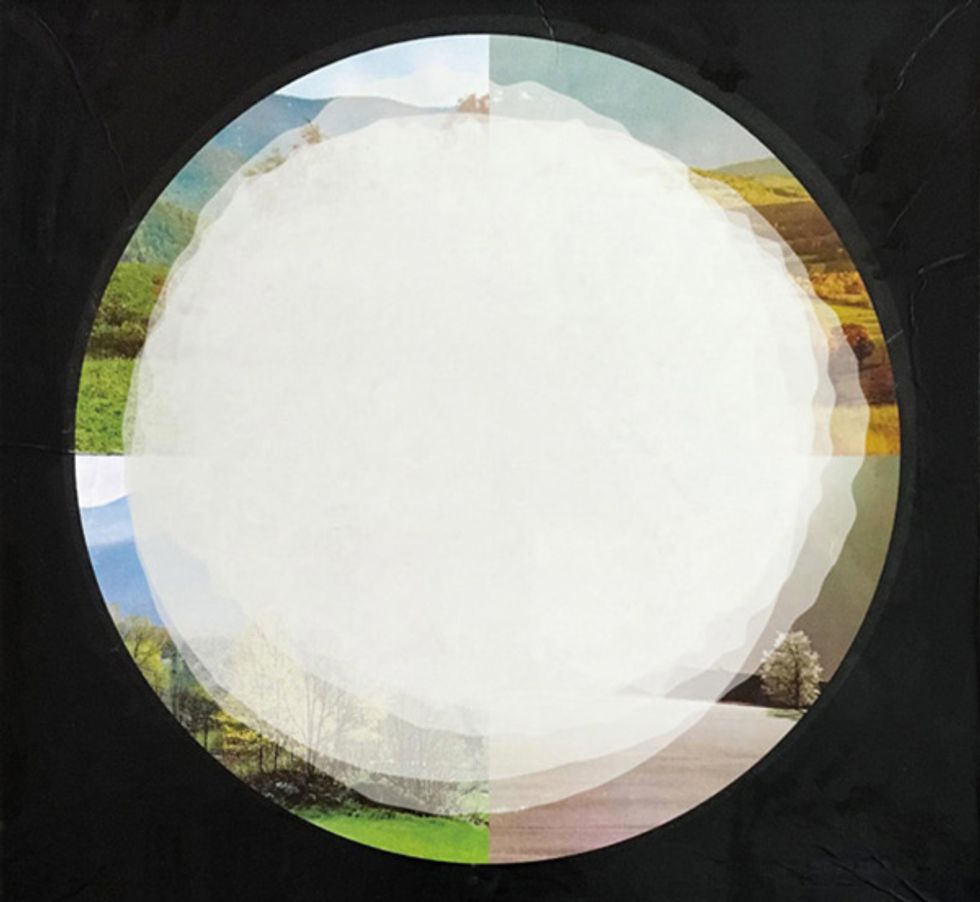
On their collaborative What's Your Sign?, Chatham and Oneida share composing credit for the album's six pieces, which are all rooted in ensemble improvisation.
As it turned out, the band was on the same page. “Kid Millions was playing free, and I was shocked and delighted," Chatham says. “I'm not a free player myself, because I'm coming out of minimalism and processed music. But the other guys—Barry [London, keyboardist], who's very handy with electronics and makes his own boxes, he was doing all these noises. And Hanoi Jane and Shahin were really making noise, and I thought, 'Oh wow, this is great!' After the first session, I said, 'So, you guys had sympathy for me and gave me something you knew I could play with, right?' And they had this blank look on their faces, like, 'Huh? No—this is how we play.' So it turned out to be a marriage made in heaven."
Inspired by their sonic chemistry, Oneida and Chatham continued to play and perform together, honing a unique, improvisation-based ensemble sound. To document this collaboration, the musicians booked time at Menegroth the Thousand Caves, a studio run by Colin Marston in New York City's Queens borough, and hit “record." This resulted in What's Your Sign?, an album comprising six compositions credited to Chatham and Oneida.
What's Your Sign? finds Chatham going a bit maximalist, which is in keeping with a pivot he's made since he started writing a series of “guitar orchestra" pieces, culminating in 2005's A Crimson Grail (for 400 Electric Guitars). Chatham's desire to duplicate that huge, multi-layered sound on his own brought him to the Line 6 DL4 delay modeler—three of them. Set to loop on eight-, nine- and 10-second intervals, together they created the effect of a regenerative, ever-changing melody. Eventually Chatham switched to the Boomerang III, which allowed him to confine the process to one box.
These spiraling sounds emerge in the sawtoothed throb of the opening track “You Get Brighter" and in the sheets of Eno-like atmospherics that elevate “Civil Weather" to oddly mesmeric heights. Chatham also explores the distinctive dropped-D just intonation tuning that has become his trademark on “The Well Tuned Guitar," which marks the first time he has used the tuning in a group setting. Reveling in its strangeness, What's Your Sign? is essentially a return to the “no wave" ethos that Chatham helped spark back in the late '70s with Guitar Trio.
Throughout his career, Chatham has tried numerous electric guitars, including an Ovation Breadwinner, an Ibanez Iceman, and, more recently, an Ibanez S series, but he's never strayed far from the Telecaster, which he uses as the basis for all his composing and recording. “That's the sound that I always have in mind," he says. “I have nothing against Gibsons, and I love playing them, too. The distortion sound of a Gibson going through a Hiwatt is just incredible. But for the compositions I do, it's a different sound. I'm really after that twangy Telecaster sound."
Chatham onstage with Oneida guitarist Hanoi “Baby" Jane. The composer describes his collaborations with the band as “a marriage made in heaven." Photo by Tim Bugbee/Tinnitus Photography
Did you have any plan at all when you set out to make this album with Oneida? It comes across almost as pure improvisation.
We all have our particular ways of playing. For example, we might say, “Okay, Shahin is going to start this improvisation, and we'll follow him," and then we'd riff off what he was doing. Or in another instance, it would be Hanoi Jane's turn, and we'd follow him. So it was like a conversation. I should underline though, these pieces started as improvisations, but they became finished pieces of music. When we play live, “You Get Brighter" always starts the same way, and it always sounds more or less the same. There are individual differences because we're not playing from sheet music, so the performance can depend on how we're feeling, but the piece always has its characteristic sound that's distinct from “Bad Brains" or “Civil Weather" or anything else on the album.
Still, by leaning on improvisation, that means you have to listen closely to each other.
That's what I also should mention: everyone in Oneida is just so generous and supportive. When someone is playing, and they're doing something “soloistic" and it draws to an end, you count on the other people to know when that's going to be, and to jump in and keep the energy going. This band is very good at doing that. And on a personal level, for a couple of years there, we were really doing a lot of playing together and touring together, so I really felt part of the band.
How did you first come across the Line 6 DL4?
Well, after I made A Crimson Grail, the question I had was, what's my next step? Am I gonna write something for a thousand electric guitars or something ridiculous? And I decided that I wanted to come back to primal music-making on my own, but I wanted it to sound like there was a lot of people, and that's when I started using loopers. By then the Line 6 was a pretty common and famous one. What I liked about it was a setting that's very similar to the Terry Riley “Poppy Nogood and the Phantom Band" sound [on Riley's 1969 album A Rainbow in Curved Air]—otherwise known as Frippertronics.
It's just too complex."
What Robert Fripp did, and what Terry Riley did 10 years before him, was to set up two Revox tape recorders 20 feet apart, and have the reel of one going to the reel of the other, thereby creating a long delay and feeding the sound of the second Revox into the first. It's a really great sound that allowed Fripp to get the effects that he did on his recordings of the '70s—and Terry obviously had an impact with “Poppy Nogood" in the '60s. It's this very eternal effect.
So in my original setup, I used three Line 6s. I put one loop at eight seconds, the second one at nine seconds, and the third one at 10 seconds. Then I would send them to the extreme left channel, the extreme right, and the center, in that order. And through the use of a Voodoo Lab amp selector, I was able to play a riff on guitar, for example, and put it into the left channel—which was looping at eight seconds, right?—then I'd play the same riff to the next channel, with the second Line 6 at nine seconds. I'd play exactly the same riff, but because the loops were different lengths, they started phasing each other, in a Steve Reich piano-phased kind of way. So instead of hearing the loop, you hear a melody that takes eight-times-nine seconds before it repeats. And because I'm using three loopers, it doesn't repeat for a long time. So it's this constantly changing and slowly evolving riff that happens.
That sounds, too, like Pythagorean Dream—the solo album you put out last year.
This is the basis, but with that I added the guitar in a dropped-D tuning—in fact, a Pythagorean tuning. The low E string is tuned down to a D, and then I tune the B string to the seventh overtone of the D string, which is a very flat C. It ends up being a bit flatter than an equal-tempered C. It's really beautiful.
Rhys Chatham's Gear
GuitarsFender Telecaster (circa 2007)
Amps
Fender Twin
Effects
Line 6 DL4 (three, for recording)
ART Studio V3 Tube MP preamp (tour)
Boomerang III (tour)
Voodoo Lab Amp Selector
MXR equalizer
Sonic Research Turbo Tuner ST-300
Strings and Picks
D'Addario EXL140 Light Top/Heavy Bottom (.010–.052)
So you're describing just intonation?
Exactly. If you take that low D string and play a harmonic on the 15th fret, that'll be the seventh overtone, so I tune up the B string to that. “The Well Tuned Guitar" with Oneida uses that tuning, which meant everybody had to retune their guitars. That was no problem for Baby Jane and Shahin. The only thing that's weird about it, for someone who isn't used to working in just intonation, is the C. So the tuning is a low D–A–D, then the A octave, and then you come to that C. But it's just a simple matter of playing that harmonic and you're there. Then the top note is a D.
Did you come in with any pre-composed
pieces for Oneida specifically?
Various cuts on the record, like “You Get Brighter" and “Bad Brains" and “Civil Weather," all those came out of these jam sessions. But yeah, the original idea for the Ecstatic Music Festival in New York [in 2012], which was where we first played together for an audience, was that I was supposed to write pieces for Oneida. “The Well Tuned Guitar" was the first one. The way I went about writing that was completely intuitive, using rhythms that are characteristic of my work coming out of Guitar Trio onwards. The thing that was different about it was primarily the tuning.
The other piece was “The Mabinogian," which is named for an early Welsh version of the King Arthur story that we're all familiar with. I just used that title because I was reading it at the time. It was all completely written out, and they were actually a little bit nervous playing it. It's not something they do every day, like classical musicians do. It worked out really nicely, and we performed it a number of times, but for the album we decided to completely mess it up. I ended up thinking that was a really good idea. “The Well Tuned Guitar," in the recorded version, is pretty much the way it originally sounded, although there are heavy effects on it. “The Mabinogian," on the other hand, is completely electronified and distorted. I was happy with the result because it blended in more with the album and made it more like an Oneida piece.
At the All Tomorrow's Parties performance you guys did together in 2013, it looks like you're standing behind a laptop.
You know what I was using it for? A stopwatch. [Laughs].
For solo gigs, Chatham has an evolved rig that includes a Mackie mixer, a Boomerang looper, and an ART Studio V3 Tube MP preamp. He often goes direct into the PA. Photo by Tim Bugbee/Tinnitus Photography
You mean, you weren't just checking your email?
It was really overkill! I hate standing onstage with a laptop, because I don't want people to think I'm running a program. There were a couple of times when I tried to use Super Looper, which is a software program that does essentially what the Boomerang or the three Line 6s will do. As a touring musician, I'm always looking for ways to make my touring gear more compact. During a certain period, it might have been around then, I had the idea that things might be lighter if I had the looper in the computer. And it was lighter, but the problem with computers is if something goes wrong onstage, you're not gonna figure it out if it happens during the concert. It's just too complex.
I use programs like Finale or Sibelius, or sequencers like Logic or Ableton Live—things like that. If I was an electronic composer working, let's say, exclusively with Ableton Live, and it was simply a matter of turning various loops on and off within the program, I'd feel confident enough with that. But the thing about Super Looper was that it had to interact with an external MIDI device, and there were just so many things that could go wrong that it scared me. I could have spent maybe six months mastering it, but I just preferred to go back to the stompboxes.
Do you have an amp preference? I've noticed sometimes on your solo shows that you go direct through a mixer.
For a long time I used the Roland Jazz Chorus 120, but I didn't turn it up very high. Three on the gain would be plenty. I liked it because of its clean sound. The hardest, most difficult amp to work with, on Guitar Trio for example, was always a Marshall. A Marshall just isn't made to be clean. It's made to put a Gibson guitar through, and to be highly distorted. It sounds great like that. But for Guitar Trio, I'd have to put the preamp on 1 or one-half just to get a halfway decent sound.
So I preferred the Jazz Chorus, but what I've been using for the last 10 years or so on tour has been the Fender Twin. It makes sense, right? Compared to the Roland, they're bloody heavy, but in general the sound works out perfectly.
Can describe some of the specifics of the Telecaster sound that appeal to you?
Well, again, it's on the twangy, trebly side, and because I'm working… you know, I got my start as a harpsichord tuner. I've always been involved in tuning, and later having studied with La Monte Young and worked with [avant-garde composer] Tony Conrad, I got into just intonation heavily. And I found that the overtones are very soft, but when you put them through an amplifier, of course they become very loud. And I've found the Fender sound has been perfect for working with these overtones directly. Like in Guitar Trio, the overtones generated by the low E string are the entire melodic vocabulary of the piece. When you first hear it, everyone is just playing the low E, but then you start hearing all this other stuff happening on top of it, which, of course, is the overtones.
That's what I've always loved about your piece. It develops slowly, but then the melodies start emerging and you can sense the movement.
Yeah, and later on in the piece it gets into angelic choirs, which are coming from the fundamental frequencies, but it's the overtones that are generated by the six strings of the guitar. I've found, for that kind of music, the Fender sound just works best for me.
What are you working on now?
I'm playing a concert in Budapest next week, which I'm really excited about because I've never been there. I've seen all those Matrix movies [laughs] and I understand it's a very beautiful city. I'm billing it as a Pythagorean Dream concert. But what I've been working on most recently is trying to change the material. I've had this set for the last year or so, and I've perfected it, so now I'm trying to break it into something else.
The next project is to develop a new son or daughter of Guitar Trio. It's a piece that'll come out of that, probably in 2018. We're hoping to develop that at the Issue Project Room in New York, with locally recruited musicians from Brooklyn. We're still settling on the guitarists, but I'll develop the music in my studio here in Paris, and then work on it with the actual musicians.
YouTube It
Compositional ground zero for Rhys Chatham is his work Guitar Trio, which was a breakthrough piece in the mid 1970s as he set out on his exploration of harmonic minimalism on guitar. For this performance at a French arts center in 2011, he's reunited with his longtime guitar foil Nina Canal, who's playing a very bright green Telecaster.
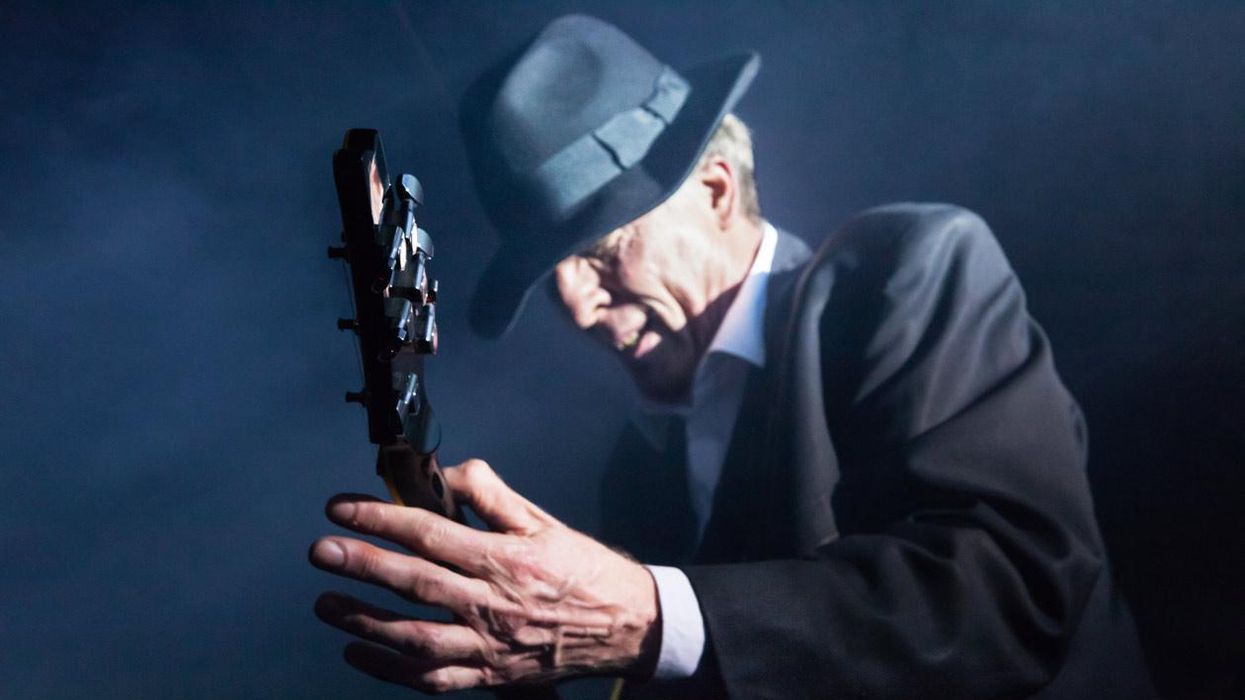
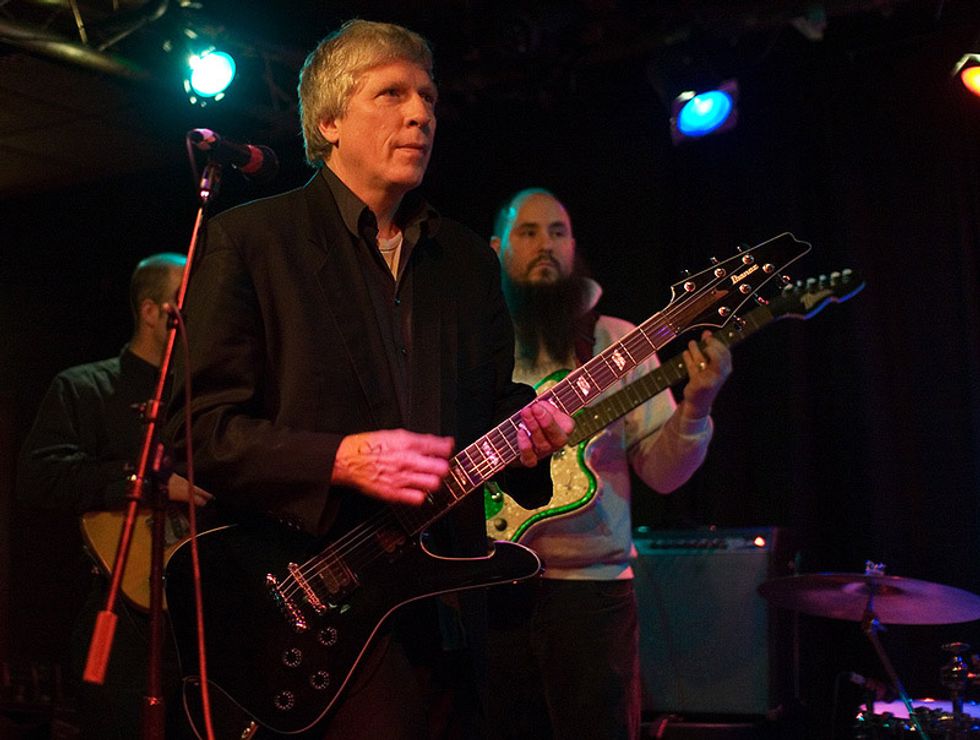
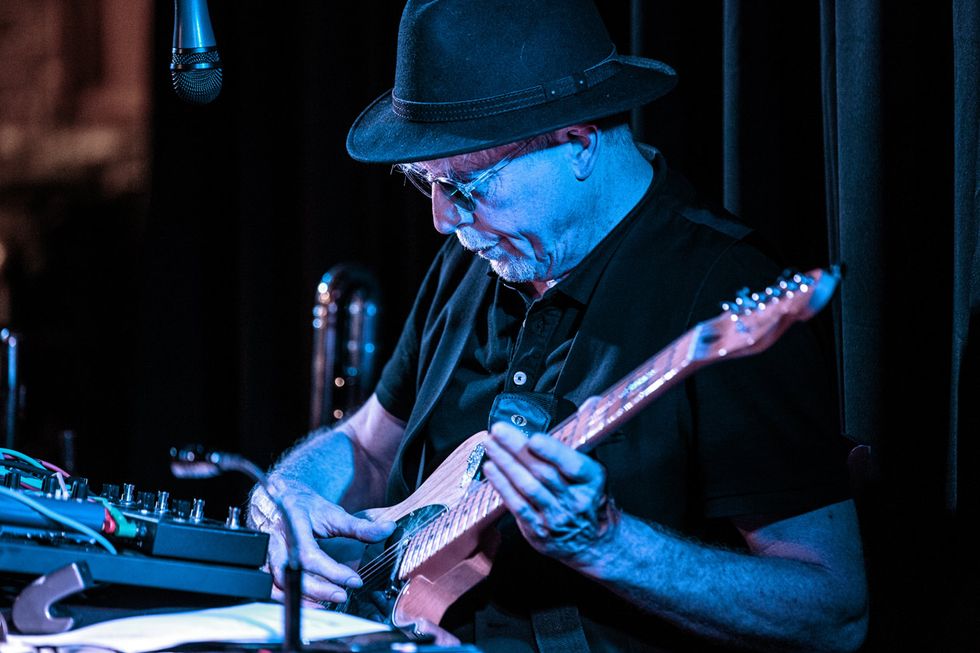





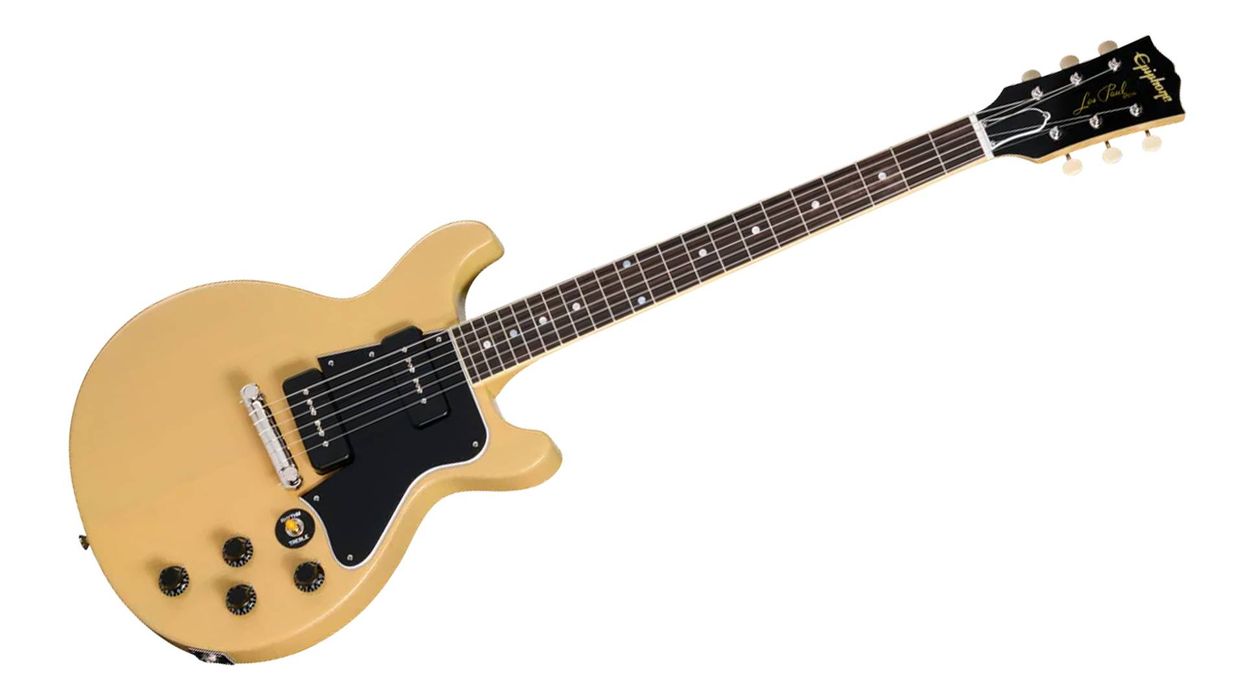















![Rig Rundown: AFI [2025]](https://www.premierguitar.com/media-library/youtube.jpg?id=62064741&width=1245&height=700&quality=70&coordinates=0%2C0%2C0%2C0)




















 Zach loves his Sovtek Mig 60 head, which he plays through a cab he built himself at a pipe-organ shop in Denver. Every glue joint is lined with thin leather for maximum air tightness, and it’s stocked with Celestion G12M Greenback speakers.
Zach loves his Sovtek Mig 60 head, which he plays through a cab he built himself at a pipe-organ shop in Denver. Every glue joint is lined with thin leather for maximum air tightness, and it’s stocked with Celestion G12M Greenback speakers.











